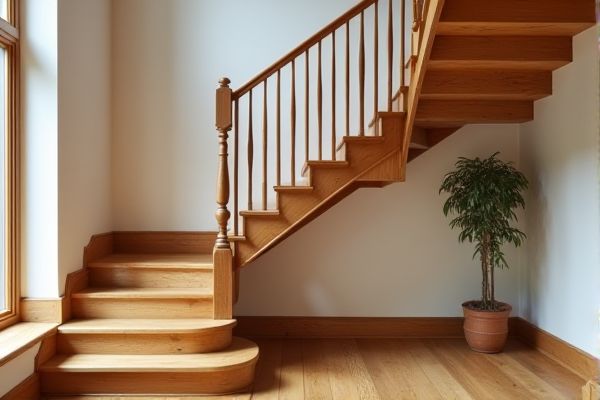
Oak stairs offer superior durability and rich grain patterns that enhance the elegance and longevity of your home, while pine stairs provide a more affordable, lightweight option with a softer texture that can be easily customized. Learn more about the pros and cons of each to determine which material best suits your style and needs in the rest of the article.
Table of Comparison
| Feature | Oak Stairs | Pine Stairs |
|---|---|---|
| Durability | Highly durable and strong | Less durable, softer wood |
| Appearance | Rich grain, dark tone | Lighter color, visible knots |
| Cost | Higher price | More affordable |
| Maintenance | Low maintenance, resists wear | Requires more care, prone to dents |
| Lifespan | Long-lasting (50+ years) | Shorter lifespan (20-30 years) |
| Suitability | Ideal for heavy traffic areas | Best for low traffic or decorative use |
Introduction to Oak vs Pine Stairs
Oak stairs offer unparalleled durability and a rich grain pattern that enhances the aesthetic appeal of your home, while pine stairs provide a more affordable, lightweight alternative with a softer texture that can be easily customized. Oak's dense hardwood structure resists dents and scratches better than pine, making it ideal for high-traffic areas and long-term use. Pine's versatility and ease of staining allow for diverse finishes, but it requires more maintenance to prevent wear over time.
Wood Characteristics: Oak and Pine Compared
Oak stairs offer exceptional durability and hardness due to their dense grain structure, making them highly resistant to wear and dents, while pine stairs feature a softer texture with a more pronounced knotty pattern that adds rustic charm but can be prone to scratches. Oak's tight grain provides a smooth, uniform finish perfect for high-traffic areas, whereas pine's lighter weight and more porous surface absorb stains unevenly, requiring careful sealing for longevity. Your choice between oak and pine stairs depends on balancing the need for strength and long-term resilience against aesthetic warmth and affordability.
Durability and Longevity
Oak stairs offer superior durability and longevity compared to pine stairs due to their dense grain structure and hardness, resisting wear and dents effectively. Pine stairs, being softer, are more susceptible to scratches, dents, and faster wear under heavy foot traffic. Over time, oak stairs maintain their structural integrity and appearance longer, making them a preferred choice for high-traffic areas.
Appearance and Grain Patterns
Oak stairs showcase a rich, pronounced grain with intricate swirls and rays, offering a classic, robust appearance that ages beautifully and maintains character over time. Pine stairs display a softer, more uniform grain pattern with knots that contribute to a rustic, warm charm but can show wear more quickly and may require frequent maintenance. The dense, coarse texture of oak contrasts sharply with the lighter, smoother finish of pine, making oak ideal for high-traffic areas requiring durability and distinctive visual impact.
Cost Differences and Budget Considerations
Oak stairs typically cost more per linear foot than pine stairs due to oak's density and durability, which contribute to its higher price in both materials and labor. Pine stairs offer a budget-friendly alternative, making them suitable for projects where cost savings are a priority without compromising basic functionality. Your choice should weigh upfront costs against long-term value, as oak stairs often require less maintenance and provide greater longevity, potentially reducing future expenses.
Installation Process and Maintenance
Oak stairs require precise installation due to their dense hardwood structure, often needing professional tools and expertise to ensure proper fitting and stability. Pine stairs offer easier installation because of their softer wood, allowing for quicker cutting and adjustments with standard tools. Maintenance for oak stairs involves regular polishing and refinishing to preserve durability and appearance, while pine stairs need more frequent sealing and touch-ups to prevent dents and wear from everyday use.
Suitability for Different Home Styles
Oak stairs, known for their durability and rich grain patterns, complement traditional, rustic, and classic home styles by adding an elegant and timeless appeal. Pine stairs, with their lighter color and softer texture, suit cottage, farmhouse, and casual interiors that benefit from a warm, inviting atmosphere and the option to easily customize with paint or stains. Your choice between oak and pine stairs should align with the overall aesthetic and functional needs of your home's design style.
Environmental Impact and Sustainability
Oak stairs, sourced from slow-growing hardwood trees, generally have a higher environmental impact due to longer growth periods and increased resource use in harvesting and processing. Pine stairs, derived from fast-growing softwood species, offer greater sustainability through rapid renewability and lower carbon footprints during production. Choosing responsibly harvested or FSC-certified oak or pine further enhances environmental benefits by promoting sustainable forestry practices.
Resale Value and Long-Term Investment
Oak stairs offer a higher resale value due to their durability, rich grain patterns, and classic appeal that attract homebuyers seeking quality finishes. Pine stairs, while more affordable upfront and easier to install, tend to show wear and dents over time, potentially lowering the home's market value. Investing in oak stairs ensures a long-term upgrade that enhances property worth and requires less frequent maintenance or replacement.
Pros and Cons: Oak Stairs vs Pine Stairs
Oak stairs offer superior durability, resistance to wear, and a rich, classic appearance, making them ideal for high-traffic areas, but they come at a higher cost and can be heavier to install. Pine stairs are more affordable and easier to work with due to their lighter weight and softer texture, allowing for quicker installation and customization, though they tend to dent and scratch more easily over time. Your choice depends on balancing long-term investment and aesthetic preferences against budget constraints and maintenance considerations.
 homyna.com
homyna.com